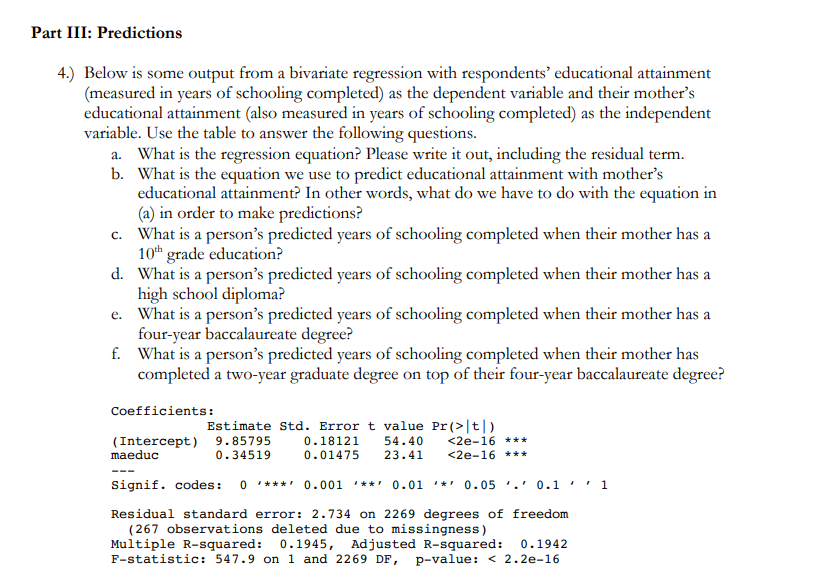4.) Below is some output from a bivariate regression with respondents' educational attainment (measured in years of schooling completed) as the dependent variable and their mother's educational attainment (also measured in years of schooling completed) as the independent variable. Use the table to answer the following questions. a. What is the regression equation? Please write it out, including the residual term. b. What is the equation we use to predict educational attainment with mother's educational attainment? In other words, what do we have to do with the equation in (a) in order to make predictions? c. What is a person's predicted years of schooling completed when their mother has a 10th grade education?
4.) Below is some output from a bivariate regression with respondents' educational attainment (measured in years of schooling completed) as the dependent variable and their mother's educational attainment (also measured in years of schooling completed) as the independent variable. Use the table to answer the following questions. a. What is the regression equation? Please write it out, including the residual term. b. What is the equation we use to predict educational attainment with mother's educational attainment? In other words, what do we have to do with the equation in (a) in order to make predictions? c. What is a person's predicted years of schooling completed when their mother has a 10th grade education?
Functions and Change: A Modeling Approach to College Algebra (MindTap Course List)
6th Edition
ISBN:9781337111348
Author:Bruce Crauder, Benny Evans, Alan Noell
Publisher:Bruce Crauder, Benny Evans, Alan Noell
Chapter3: Straight Lines And Linear Functions
Section3.CR: Chapter Review Exercises
Problem 15CR: Life Expectancy The following table shows the average life expectancy, in years, of a child born in...
Related questions
Concept explainers
Transformation of Graphs
The word ‘transformation’ means modification. Transformation of the graph of a function is a process by which we modify or change the original graph and make a new graph.
Exponential Functions
The exponential function is a type of mathematical function which is used in real-world contexts. It helps to find out the exponential decay model or exponential growth model, in mathematical models. In this topic, we will understand descriptive rules, concepts, structures, graphs, interpreter series, work formulas, and examples of functions involving exponents.
Question
I need help with A-F

Transcribed Image Text:Part III: Predictions
4.) Below is some output from a bivariate regression with respondents' educational attainment
(measured in years of schooling completed) as the dependent variable and their mother's
educational attainment (also measured in years of schooling completed) as the independent
variable. Use the table to answer the following questions.
a. What is the regression equation? Please write it out, including the residual term.
b. What is the equation we use to predict educational attainment with mother's
educational attainment? In other words, what do we have to do with the equation in
(a) in order to make predictions?
c. What is a person's predicted years of schooling completed when their mother has a
10th grade education?
d. What is a person's predicted years of schooling completed when their mother has a
high school diploma?
e. What is a person's predicted years of schooling completed when their mother has a
four-year baccalaureate degree?
f. What is a person's predicted years of schooling completed when their mother has
completed a two-year graduate degree on top of their four-year baccalaureate degree?
Coefficients:
Estimate Std. Error t value Pr(>|t|)
9.85795
0.34519
<2e-16 ***
<2e-16 ***
0.18121
54.40
(Intercept)
maeduc
0.01475
23.41
Signif. codes:
0 * ***' 0.001 '**' 0.01 '*' 0.05 '.' 0.1 ' ' 1
Residual standard error: 2.734 on 2269 degrees of freedom
(267 observations deleted due to missingness)
Multiple R-squared: 0.1945, Adjusted R-squared:
F-statistic: 547.9 on 1 and 2269 DF, p-value: < 2.2e-16
0.1942
Expert Solution
This question has been solved!
Explore an expertly crafted, step-by-step solution for a thorough understanding of key concepts.
Step by step
Solved in 4 steps

Knowledge Booster
Learn more about
Need a deep-dive on the concept behind this application? Look no further. Learn more about this topic, statistics and related others by exploring similar questions and additional content below.Recommended textbooks for you

Functions and Change: A Modeling Approach to Coll…
Algebra
ISBN:
9781337111348
Author:
Bruce Crauder, Benny Evans, Alan Noell
Publisher:
Cengage Learning

College Algebra
Algebra
ISBN:
9781305115545
Author:
James Stewart, Lothar Redlin, Saleem Watson
Publisher:
Cengage Learning


Functions and Change: A Modeling Approach to Coll…
Algebra
ISBN:
9781337111348
Author:
Bruce Crauder, Benny Evans, Alan Noell
Publisher:
Cengage Learning

College Algebra
Algebra
ISBN:
9781305115545
Author:
James Stewart, Lothar Redlin, Saleem Watson
Publisher:
Cengage Learning


Glencoe Algebra 1, Student Edition, 9780079039897…
Algebra
ISBN:
9780079039897
Author:
Carter
Publisher:
McGraw Hill

Big Ideas Math A Bridge To Success Algebra 1: Stu…
Algebra
ISBN:
9781680331141
Author:
HOUGHTON MIFFLIN HARCOURT
Publisher:
Houghton Mifflin Harcourt